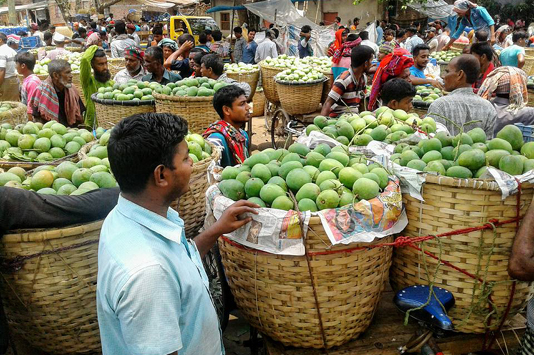By Dr Aynal Haque
RAJSHAHI, June 27, 2020 (BSS) – Mango harvesting season has emerged as a way of income source for many Rajshahi students particularly in current coronavirus pandemic situation as the deadly virus forced the authorities to close every educational institutions across the country.
Since all educational institutions remained shut following government directives to tackle COVID-19, so the students are at home and passing idle time as well. But, fortunately, mango has become a blessing for them in the region consisting Rajshahi, Chapainawabgonj, Naogaon and Natore districts.
During the current peak season, the students of schools, colleges and universities are seen engaged in mango plucking, transportation, segregation and packaging with much interest.
Apart from this, many of them are involved in online-based mango trading directly by best uses of information and communications technologies, making profit.
Hossain Ali, a student of Peergachha-Tethulia Vocational and Technical College, has been working in a mango orchard at the Pirgachha village under Bagha Upazila along with other professional labourers equally for the last couple of days. He earns Taka 500 per day for mango plucking and transportation from the orchard to local markets.
Munna Aziz, a third-year honours student in the Department of Islamic History of Ishwardi Government College, is doing works of mango bagging in an orchard owned by Arun Kumar Sarker at Arpara village of the same upazila.
Upazila Agriculture Officer Shafiullah Sultan said more than 1,500 students are working only in the Bagha Upazila areas making them financially solvent along with helping their parents.
He said hundreds of young entrepreneurs are also involved in the online mango business in the region at present. After getting online orders, they are plucking mango from the orchards, packaging on the spot and finally sending those to the clients in various destinations including the capital Dhaka and port city Chattogram through courier services.
Manu Mohan Bappa, a student of the Department of Fine Arts in Rajshahi University, has been operating the online mango business successfully from his village home at Rahanpur in Chapainawabganj since the season began.
Through his Facebook page ‘Rainbow Mango Station’, he has already sold 60 maunds of Gopal Bhog and Khirsapat mango varieties to different parts of the country this season.
Bappa said they have mango orchards on around 100 bighas of land. In addition to this, they have bought orchards with 600 trees of Khirsapat and Langra mangoes.
He said mangoes are being sold through about 30 online mangos selling Facebook pages only in Rahanpur. Mangoes are also being sold through displaying live on Facebook, Messenger, Imo and WhatsApp.
Abu Sayem, a mango farmer of Sagaril village in Chapainawabganj, said they have about 100 mango trees and have sold mangoes to traders from the garden online. They got good price and could save transporting cost.
Anwarul Haque, President of Rajshahi Agro Food Producer Society, said currently more than 6,000 students are engaged in various money-making and innovative activities in the region.
Meanwhile, both wholesale and retail mango markets are seen bustling with all varieties of mangoes during the current peak season of the delicious fruit despite the COVID-19 pandemic.
Huge supply of different varieties of mangoes like Langra and Khirsapat, superior varieties of mango known for their taste and flavour, along with some other local varieties have appeared in the markets in abundance at present. Sudhendra Nath Roy, additional director of the Department of Agriculture Extension (DAE), said there are more than 2.60 lakh mango growers and orchard owners in the region.
Around 1.30 lakh people are engaged in various activities related to mango harvesting, segregating, packaging, transporting and marketing.
He added that the DAE has set a target of harvesting around ten lakh tonnes of mangoes from 80,360 hectares of land in the region this season while last year’s production was 8,31,940 tonnes from 72,909 hectares of land.



